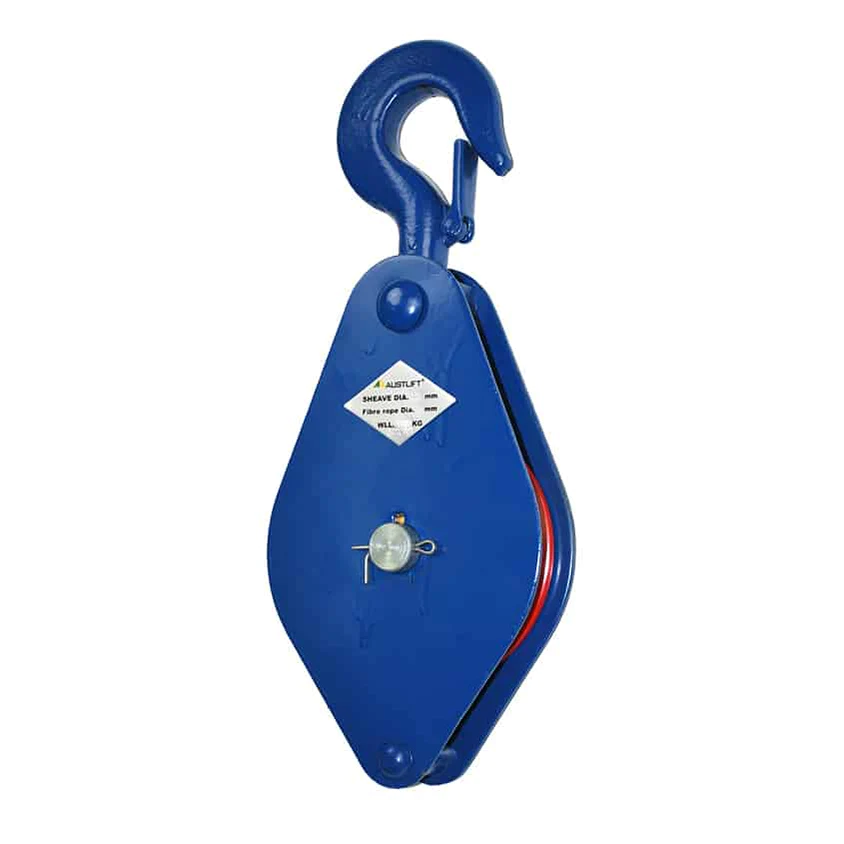I will not say that sheave block is a common name, but I can also assure you that each of you has come across one while passing through a construction site. What are these? Have you ever seen one?
Sheaves are known as pulleys. When one uses two or more pulleys together for extra strength, they are sheave blocks. Sheave blocks are available in different types. They are either single, double, triple, or quadruple blocks. One can use them in many combinations to increase pulling or lifting capacity. They are common lifting tools used for rigging. They are combined with a cable, belt, or rope to lift loads with the crane.

There are many types of sheave blocks. You need to compare several things while you choose one. Starting from your usage, budget, place of use, durability, and several other factors you need to recall before you stick to one. For right now, Let’s check how many of them exist presently. Check them one by one:
1. Single sheave block-:
The primary usage of a single sheave block is for lifting and pulling operations. They are simple mechanical equipment used to change the direction of the wire rope or cable. They are used to lift or pull heavy loads. Their body comprises steel with zinc plating. It helps in redirecting the path of the wire rope.
2. Double sheave block-:
Use a double sheave block to lift loads of an indicated amount. It is also known as “block and tackle .”To extend pulley life, each pulley has an oil-infused bearing. It is a system where two or more pulleys are threaded with a rope or cable. On construction sites, they are used to lift heavy loads. The double sheave block can lift the weight with half the force applied.
3. Triple sheave block -:
The triple sheave block is the largest, comprising three gray iron plain bore sheaves. Users use them for Fibre or wire rope. It is also available with steel sheaves and sintered bronze bush. For rope wire use, it is available with ball bearings. It helps to lift heavy loads efficiently. In the rigging combination, a triple sheave block increases the pulling power. It is good for changing the direction of the pull.
4. Cable block-:
A cable block lays cable channels with wells to enter pipes and channels. In construction, it helps to reduce the risk of damage during lashing and positioning. It helps to prevent the sagging of aerial cables. With great ease and efficiency, cable blocks help to place and support copper cables from one pole to another. Cable blocks help to relieve stress, which is placed on the cable when pulled. They are magnetic cables of premium silicone blocks. Cable blocks come in various shapes and sizes, which you can arrange with one or more pulleys.
5. Snatch block-:
A snatch block is a pulley to pull ropes with the help of winches. Covered by a metal case, people use it to lessen the load on the winch. You will find them being commonly used in offshore applications. It helps in increasing the capacity of the rope. It also helps in diverting the direction of the rope. You will find them at multiple places, like construction, rigging applications, lifting, etc. In construction, people use it to increase the pulling power of the loads. It helps in improving the life probability of the rope or winch.
6. Travelling block-:
A traveling block is a set of sheaves that lower and lift heavy things into and out of the wellbore. It moves up and down in the derrick. It helps to support the drill column as it travels up and down when it hoists the pipe out of the hole and lowers it. It can contain three to six sheaves depending on the load and the mechanical advantage required. It helps in lifting and dragging heavy objects.
7. Nylon block-:
Nylon blocks help especially to pull, lift, and reeve loads. They also help in diverting synthetic rope and wires. It is applied in construction lines to lift heavy loads.
8. Manila block-:
You will find this manila sheave block made up of standard-grade forged steel or alloy steel. At sites, people use it to lift heavy cargo. The material handling power of the Manila block is attached to the cranes. The working life of the Manila sheave block is very long. People use them in rigging and military training areas. Manila rope is salt water resistant. It is easy to install and very simple to maintain. It can carry high loads.
9. Construction block-:
These blocks are mainly usable at construction sites. They are designed for rigging and lifting heavy loads on construction sites. One can customize them according to the needs of the construction site.
10. Wire rope block-:
The purpose behind the wire rope block is to lift or lower heavy loads. It helps in the smooth changing of direction of the rope or wire. The wire rope block is divisible into three parts. They are the core, the strand, and the wire. The core helps to hold the rope together. Steel wire rope lifts loads weighing between 2 and 30 tons. People use it to lift cranes in construction projects. Wire rope blocks lift goods and pulling operations in power line construction.
Wrapping up
One can choose sheave blocks according to the type of construction project. Sheave blocks of different types are usable in different lifting projects on construction sites. It provides a smooth crane operation. Sheave blocks redirect the path of wire rope and are functional to give a mechanical advantage. Sheave blocks play an important role in different types of applications. From hoisting up a sail to moving heavy loads efficiently, they are all done by the sheave blocks. Next time you pass a construction site, check what kind of sheave block they are using. I am sure by now you can decode what type of block they are! So when are you visiting one?



